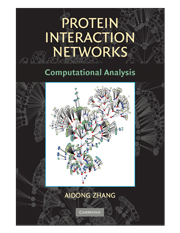Book contents
- Frontmatter
- Contents
- Preface
- 1 Introduction
- 2 Experimental Approaches to Generation of PPI Data
- 3 Computational Methods for the Prediction of PPIs
- 4 Basic Properties and Measurements of Protein Interaction Networks
- 5 Modularity Analysis of Protein Interaction Networks
- 6 Topological Analysis of Protein Interaction Networks
- 7 Distance-Based Modularity Analysis
- 8 Graph-Theoretic Approaches to Modularity Analysis
- 9 Flow-Based Analysis of Protein Interaction Networks
- 10 Statistics and Machine Learning Based Analysis of Protein Interaction Networks
- 11 Integration of GO into the Analysis of Protein Interaction Networks
- 12 Data Fusion in the Analysis of Protein Interaction Networks
- 13 Conclusion
- Bibliography
- Index
2 - Experimental Approaches to Generation of PPI Data
Published online by Cambridge University Press: 28 January 2010
- Frontmatter
- Contents
- Preface
- 1 Introduction
- 2 Experimental Approaches to Generation of PPI Data
- 3 Computational Methods for the Prediction of PPIs
- 4 Basic Properties and Measurements of Protein Interaction Networks
- 5 Modularity Analysis of Protein Interaction Networks
- 6 Topological Analysis of Protein Interaction Networks
- 7 Distance-Based Modularity Analysis
- 8 Graph-Theoretic Approaches to Modularity Analysis
- 9 Flow-Based Analysis of Protein Interaction Networks
- 10 Statistics and Machine Learning Based Analysis of Protein Interaction Networks
- 11 Integration of GO into the Analysis of Protein Interaction Networks
- 12 Data Fusion in the Analysis of Protein Interaction Networks
- 13 Conclusion
- Bibliography
- Index
Summary
INTRODUCTION
Proteins and their interactions lie at the heart of most fundamental biological processes. Typically, proteins seldom act in isolation but rather execute their functions through interaction with other biomolecular units. Consequently, an examination of these protein-protein interactions (PPIs) is essential to understanding the molecular mechanisms of underlying biological processes. This chapter is intended to provide an overview of the more common experimental methods currently used to generate PPI data.
In the past, PPIs were typically examined via intensive small-scale investigations of restricted sets of proteins of interest, each yielding information regarding a limited number of PPIs. The existing databases of PPIs have been compiled from the results of such small-scale screens presented in individual research papers. Since these data are subject to stringent controls and evaluation in the peer-review process, they can be considered to be fairly reliable. However, each experiment observes only a few interactions and provides a data set of limited size.
Recent high-throughput approaches involve genome-wide detection of protein interactions. Studies using the yeast two-hybrid (Y2H) system, mass spectrometry (MS), and protein microarrays have generated large amounts of interaction data. The Y2H system takes a bottomup genomic approach to detecting possible binary interactions between any two proteins encoded in the genome of interest. In contrast, mass spectrometric analysis adopts a top-down proteomic approach by analyzing the composition of protein complexes. The protein microarray technology simultaneously captures the expression of thousands of proteins.
- Type
- Chapter
- Information
- Protein Interaction NetworksComputational Analysis, pp. 11 - 20Publisher: Cambridge University PressPrint publication year: 2009



